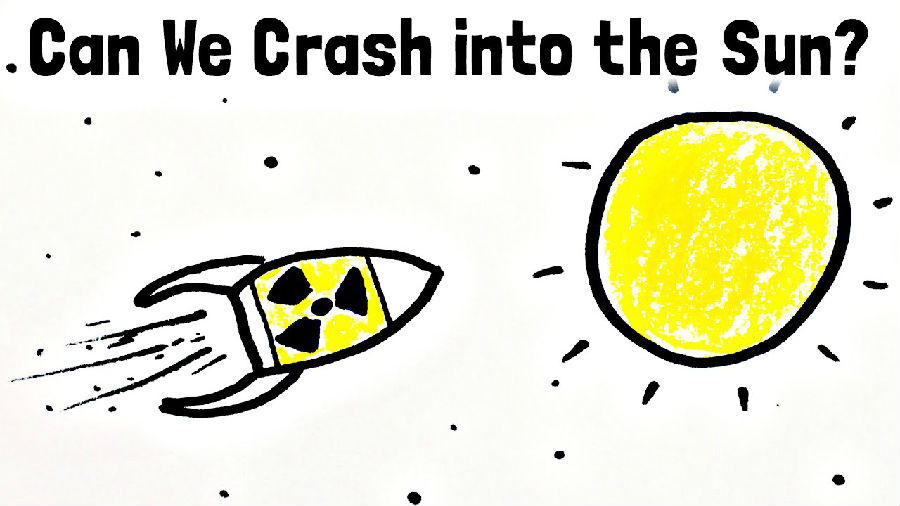Nuclear waste. We've got a lot of it, it'll stay dangerous for tens of thousands of years,
核废料,我们有很多,它的危险性可存数百万年,
and we don't really know what to do with it.
并且我们不知道如何处理它。
So why don't we just send it into space and crash it into the sun?
所以我们为什么不把它发射到太空然后撞向太阳呢?
Well, first, it's really dangerous to put nuclear waste on a rocket,
好吧,首先,把核废料放在火箭上真的很危险,
since rockets have a tendency to occasionally explode while launching,
因为火箭在发射时偶尔会爆炸,
making any nuclear-waste-filled exploding rocket into a really big dirty bomb.
任何装满核废料的火箭一旦爆炸,就会变成一个大脏弹。
But the bigger reason is that it's actually really really hard to get to the sun.
但更重要的原因是它实际上非常非常难以抵达太阳。
It might seem like it should be easy, since the sun's gravity is always pulling us towards it.
好像看起来应该很简单,因为太阳的引力总是把我们拉向它。
But we're also orbiting really fast sideways around the sun, so that as we fall towards it, we miss it.
但我们也在绕着太阳快速旋转,所以当我们朝太阳下落时,我们就会偏离它。
In order to crash into the sun, you have to slow down so that you're not going sideways really fast.
为了撞向太阳,你要降低绕着太阳公转的速度才行。
The earth - and everything on it - is moving around the sun at around 30 kilometers per second,
地球以及地球上所有东西,大约以每秒30公里的速度绕着太阳公转,
so you'd have to accelerate to a speed of 30kilometers per second backwards away from the earth
所以你必须要朝着与地球公转相反的方向加速到每秒30公里
in order to stop moving around the sun and do a sun dive.
以抵消地球公转的速度,才能落到太阳上。
And you have to slow down all the way – with even a little bit of sideways speed, you'll miss the sun and whip around, not crashing.
而且你必须完全减速——即使是一点点侧移的速度,你也会偏离太阳,四处乱转,而非坠落。
Ok, so a speed of 30 kilometers per second is really fast, but just how fast? Well, from earths's orbit,
所以30千米每秒的速度真的很快,但是到底有多快呢?从地球轨道上,

you only need to be going 11 kilometers per second faster than the earth in order to escape from the entire solar system.
你只需比地球公转速度快每秒十一公里,便能脱离整个太阳系。
Which means that it's much, much harder to crash into the sun than to escape it altogether.
这意味着想要降落到太阳上比想要脱离太阳更难。
Let me say that again: it takes less acceleration to get to other stars than it does to get to our own sun. Crazy.
再说一次:前往其他恒星所需的加速度比前往自家的太阳少。太疯狂了。
But it gets weirder: because the gravity from an object is stronger the closer you are to it,
但还有更奇怪的:因为你离物体越近则引力越强,
the smaller your orbit is, the faster your orbital speed.
环绕的轨道越小,则环绕速度需越快。
For example, Mercury goes around the sun at a speed one and a half times faster than earth, while Pluto goes only a sixth as fast.
例如,水星环绕太阳的速度是地球的1.5倍,而冥王星的速度只有地球的六分之一。
And that means it's actually way harder to crash into the sun from Mercury
这意味着从水星撞向太阳要比从地球撞到太阳困难得多,
than from the earth, even though you're closer,
即使你离地球更近,
because you'd have to accelerate to a speed of 48 kilometers per second backwards instead of 30.
因为你得加速到每秒向后48公里,而非30公里。
And it's way easier to crash into the sun from Pluto,
而从冥王星撞太阳则简单很多,
since you only have to accelerate to a speed of five kilometers per second backwards.
你只需要加速到每秒向后5公里。
In fact, if you're trying to crash into the sun just using rockets,
事实上,如果你想单靠火箭坠向太阳,
it's far more efficient to first go to the outer solar system where your speed is much lower,
更有效率的作法是先前往外太阳系让公转速度減慢,
then do a second burn to counteract that slow orbital speed and allow you to fall directly into the sun.
然后点火二次抵消较慢的公转速度,让你直接掉向太阳。
And that's precisely why early mission trajectories for NASA's spacecraft
这就是为什么NASA早期的太阳研究任务
to study the sun proposed going out to Jupiter first – to make it easier to slow down and get to the sun.
提议先去木星——为的是更快减速前往太阳。
Ultimately, they decided instead to use repeated flyby's of Venus to slow down the probe and save on rocket fuel getting to the sun.
最后,他们决定使用反复飞越金星的方法来减慢探测器的速度,并节省火箭燃料到达太阳。
But how gravity assists work is a topic for another day. Speaking of which – how long would a day be on the sun?
但关于重力助推的运作原理就改天再谈吧。说到这里,太阳上的一天有多长?


